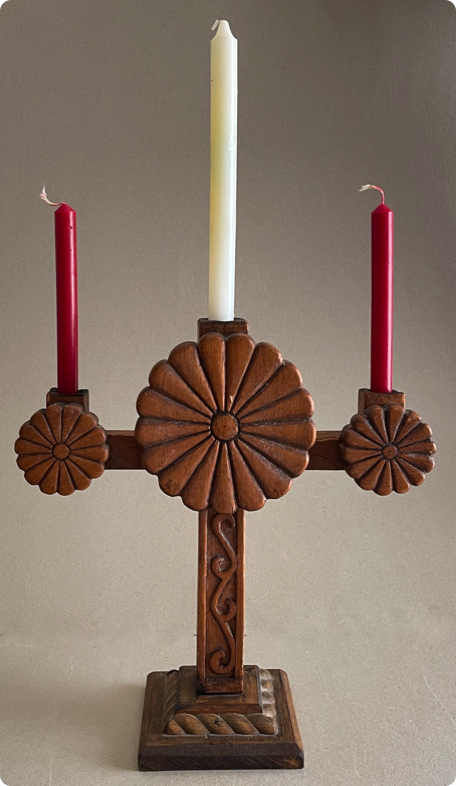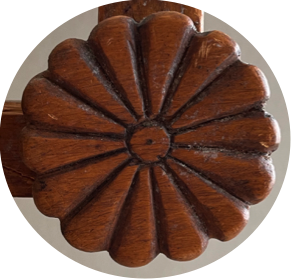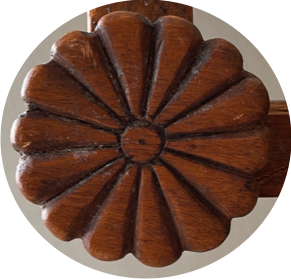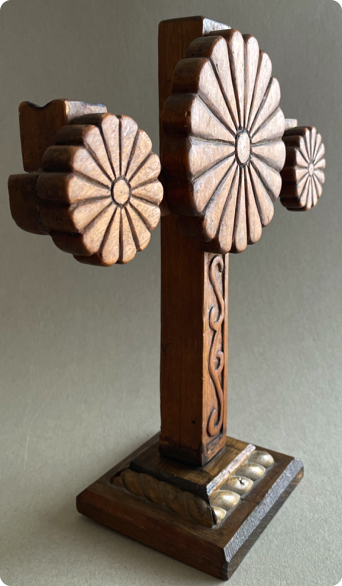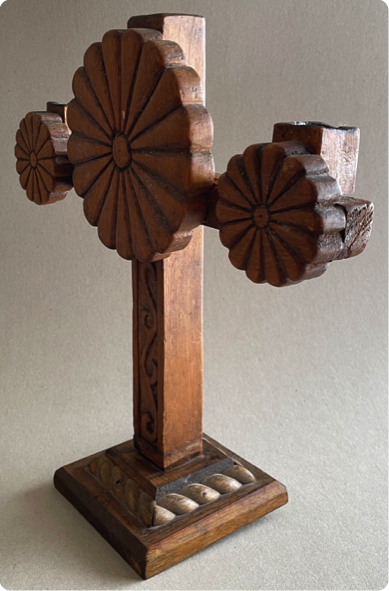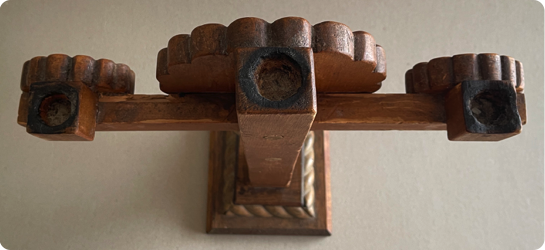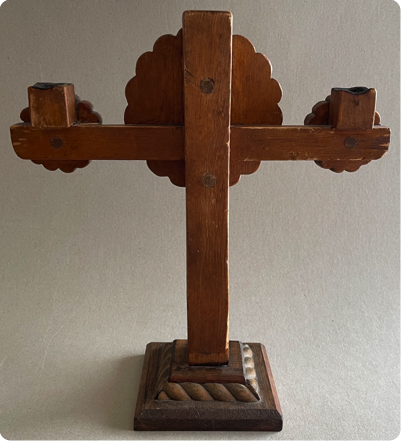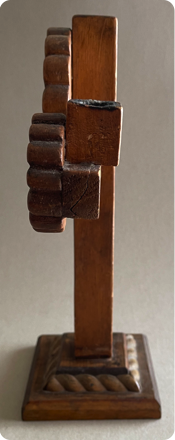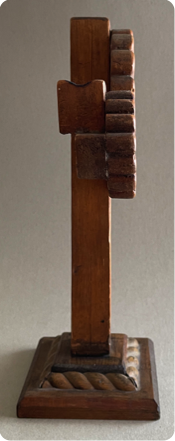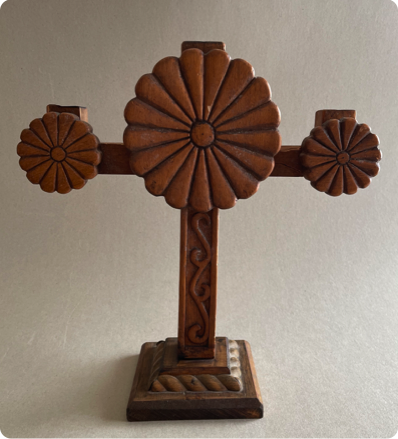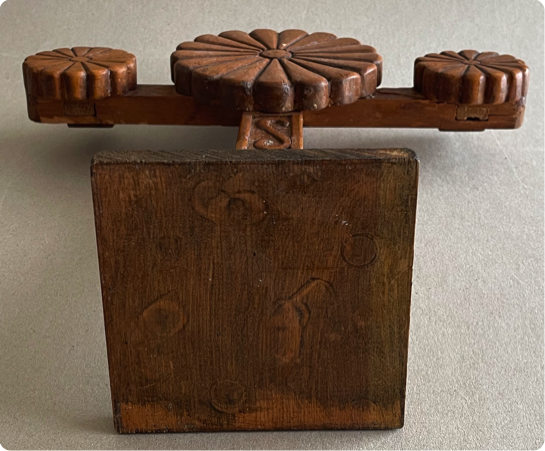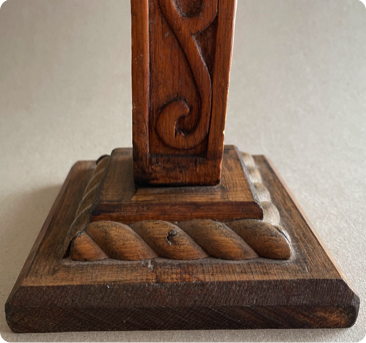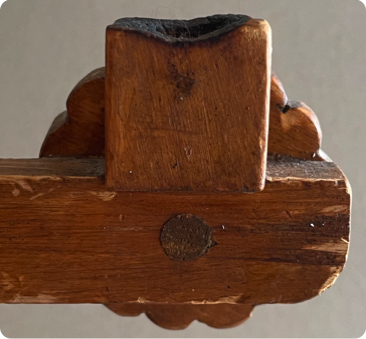
© 2010-2024 by Fine Arts of the Southwest, Inc. All rights reserved.
Unauthorized reproduction or use is strictly prohibited by law.
An exceptionally beautiful and extremely well-made
WPA-Period Taos, New Mexico hand-carved three-arm wooden candelabra, possibly by Maximo (Max) Luna, c. 1930’s-40’s
This beautiful piece was recently discovered in an old adobe home in Taos, New Mexico by a longtime colleague of ours. To say that this is a lovely and striking piece is to understate it by half. This piece is just wonderful, probably the finest example of its kind we have seen and the New Mexico woodwork of the WPA-Period was usually of considerable quality. This piece shows the hand of a particularly skilled artisan and this plus the fact that it was found in Taos points us in the direction of the great Taos WPA-Period woodcarver, Maximo L. (Max) Luna (1896-1964.)
While there is no way to be certain of this, a visual comparison of this piece to some of Luna’s documented work such
as the trastero pictured below is fairly convincing, but whether it is indeed by Luna’s hand or not, it is an undeniably fine piece. The three-branched candelabra is made of hand-carved and adzed local Ponderosa pine wood built with classic New Mexico mortise, tenon and peg construction. Starting from the bottom up, there is a finely rope-carved square base from which rises a beautifully-carved square-shaped vertical central stem upon which is hung a square-shaped horizontal wood cross bar which features three beautifully-carved applied round wood rosettes, a large one in the center and two matched smaller ones on each side behind which are the three recessed bases which hold the candles.
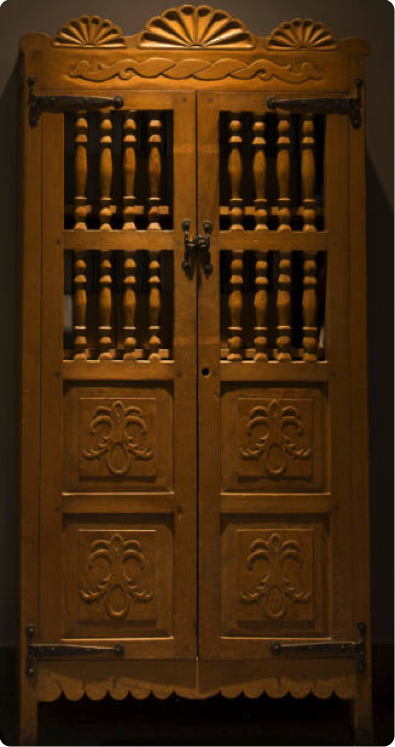
"Maximo (Max) Luna was an important figure in the resurgence of interest in the "Spanish Colonial Style" during the 1930's. Already an established furniture maker when he began teaching for the State Department of Vocational Education (SDVE) in 1936, Luna created hand-carved, mortise-and-tenon furniture for the Harwood Foundation in Taos. Additionally, he hand forged all the iron fittings for his pieces and did ornamental tinwork."
Text and photo source and © Museum of International Folk Art, Santa Fe
“The WPA (Works Progress Administration) was created during this time to support unemployed artists throughout the country. In New Mexico, 160 artists created public art in 29 New Mexican communities. The WPA supported a wider range of projects in public buildings and supported artists and craftsmen making prints, paintings and photographs, as well as traditional Hispanic and Native American artworks.”
-Quotation source and © Wikipedia


Maximo L. Luna carved wooden trastero, Taos, NM, c. 1940, in the collection of the Harwood Foundation Museum, Taos, NM
Trastero photo source and © The Harwood Foundation Museum
The candelabra itself without any candles measures 14 1/2" in height and it is 13 3/4" in width and 5 1/2" in depth at the base. The candelabra is in generally excellent original condition, particularly for its 80-90 years of age. It has a very fine, soft patina from age and use with some organic deposits, likely wax and dust. There is a small chip in the wood of the central rosette and an approximately two-inch crack or split in the wood front in the right arm of the piece, but this is not visually intrusive. There is a small area of what appears to be water damage where the stem meets the base. Also, the fixture stands just very slightly off the vertical, with a slight lean to the right because of how the wood stem was attached to the base. This could be easily corrected if desired by a qualified wood repair person but we think this slightly cockeyed stance just adds to the handmade rustic New Mexico charm of this piece and we ourselves wouldn’t touch it, leaving that decision instead to its next very fortunate owner.
The WPA Period in New Mexican art was a fertile and productive time and place for the continuation of traditional village arts and crafts, such as furniture-making, figural woodcarving, tin-smithing, painting, printing, weaving and Colcha embroidery. While this lovely candelabra succeeds most admirably and well at a functional and craft level,
in our opinions, its elegant form, exceptional artistry and exalted aesthetic presentation brings it much more firmly
into the larger worlds of Folk Art and Fine Art. Que Viva Nuevo Mexico!
SOLD
